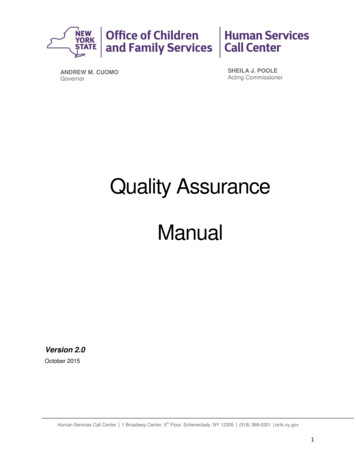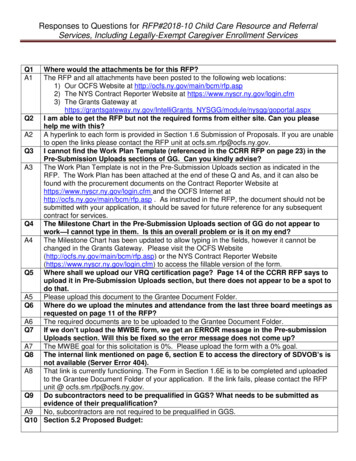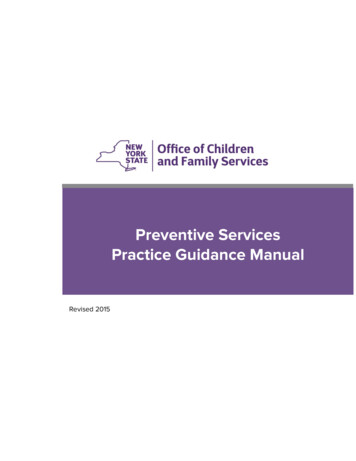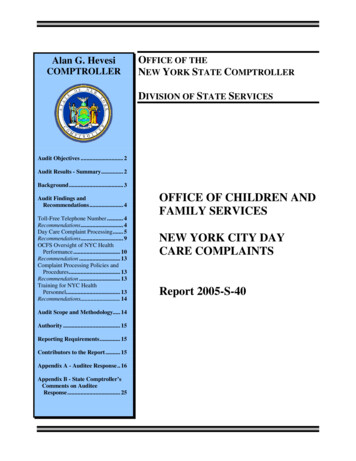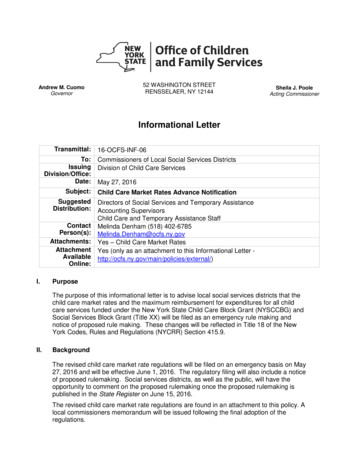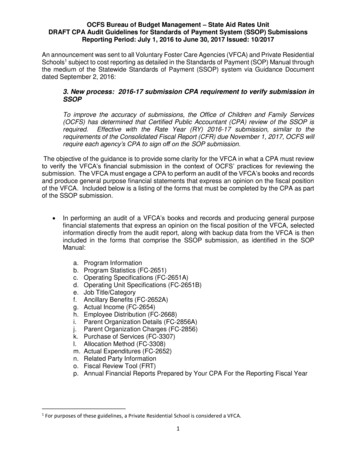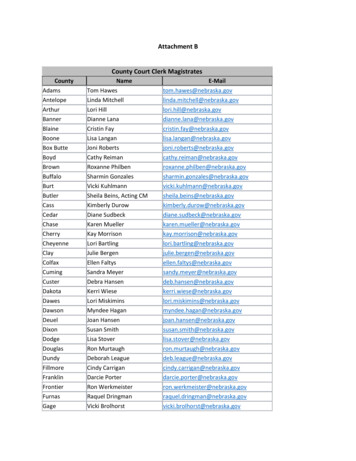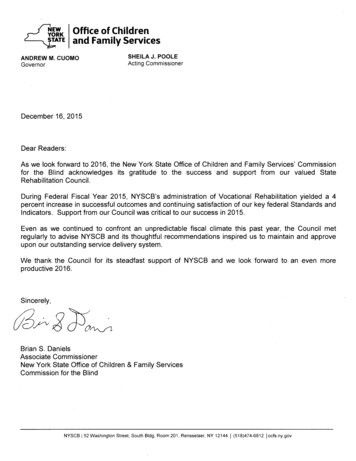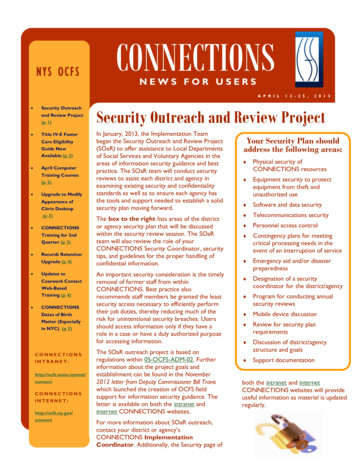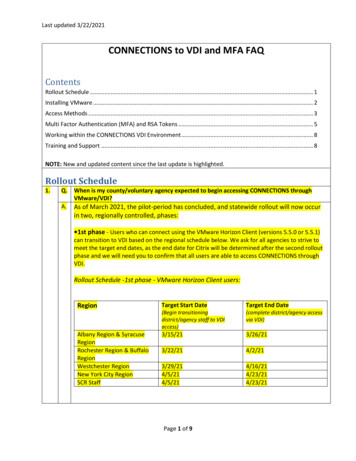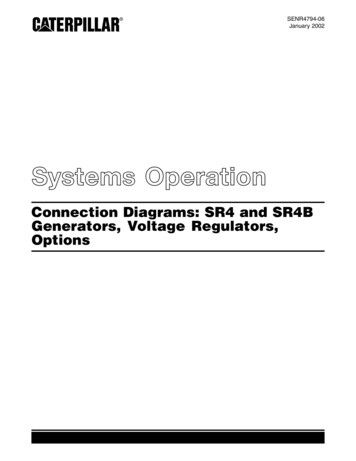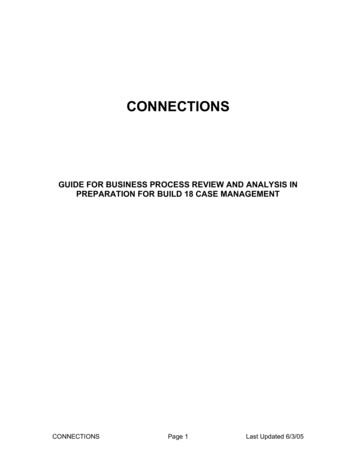
Transcription
CONNECTIONSGUIDE FOR BUSINESS PROCESS REVIEW AND ANALYSIS INPREPARATION FOR BUILD 18 CASE MANAGEMENTCONNECTIONSPage 1Last Updated 6/3/05
INTRODUCTION. 3ACKNOWLEDGEMENTS . 4MANAGING THE IMPACTS AND CHANGES . 6Family Services Intake initiated through CPS in Local District. 16Case Opening Process (Until CONNECTIONS Financial Management – Build 19 – isimplemented) . 19Questions and Considerations . 19Making Assignments and transferring case assignments in the open case. 22Questions and Considerations . 22Family Assessment and Service Planning . 25Questions and Considerations . 25Service Plan Reviews . 28Questions and Considerations . 28Documenting Changes that occur in the Case. 31Questions and Considerations . 31APPENDIX A . 33CONNECTIONSPage 2Last Updated 6/3/05
INTRODUCTIONAs part of the larger CONNECTIONS Project of OCFS, the Implementation ManagementBureau is responsible for preparing district, agency, regional, and state staff for theimplementation of a comprehensive automated information system for social services.This includes change management, training, on-site support, and communication tostakeholders and end users. A wide range of tools will be used by the project staff toorient users to the system; build the capacity of user agencies; and assist users inproactively preparing for the changes that an automated system can make. One ofthose tools is Business Process Reengineering (BPR). This is a method that includesthe critical analysis of existing business processes and the redesign of these processesin an effort to streamline and improve the day-to-day operations of child welfare districtsand agencies using the new automated system of case management.The outcomes and benefits expected from analyzing and redesigning businessprocesses that will directly use CONNECTIONS or be impacted by the use ofCONNECTIONS changes in policy or by the use of CONNECTIONS will be that: Districts/ agencies will be able to critically examine how work is currently beingconducted or processed in their own organization and assess ways to reduceredundancy with system functionality, identify and eliminate processes andprocedures that CONNECTIONS will render unnecessary, and improveefficiency.Staff will become exposed to the ways in which CONNECTIONS can support thework of their organization and be a useful tool for casework decision making,documentation and case management.Districts/ agencies who share responsibilities for provision of services will be ableto cooperatively develop redesigned work processes that will be the mostefficient and effective for all involved.Processes across district and agency organizations will become morestandardized, and the number of methods by which each district and agencymust operate will be reduced.This guide has been prepared to give district and agency staff assistance in preparing toimplement the CONNECTIONS Case Management application. As a result of thechanges that an automated system of case documentation brings, it is recommendedthat all districts and agencies make the review and analysis of current and proposedbusiness processes a part of the implementation preparation activities.The methods and tools presented in this guide can be used individually by each districtand agency to assess and redesign internal work processes as well as to refine crossagency work processes. The overall set of tools, which are covered in Appendix B, canbe used by the CONNECTIONS Implementation staff at Regional ImplementationSupport Team (RIST) meetings, and at other planned meetings with your staff.CONNECTIONSPage 3Last Updated 6/3/05
ACKNOWLEDGEMENTSSpecial thanks go to the three Local Departments of Social Services and threeVoluntary Agencies that participated in piloting our work on Business ProcessReengineering. They devoted substantial staff time to participate in user groupsto examine and document current work processes in their locations; to study thenew functionality of CONNECTIONS Build 18; to discuss how the automation willaffect their current work processes; and to meet jointly with the district or agencyin their locale to begin cooperatively developing the model processes you will seedocumented in this guide. We could not have done this without their assistance.CONNECTIONS Implementation thanks:Schenectady County Department of Social ServicesLaura Velez, Director of ServicesJean Nicholas, Implementation CoordinatorDutchess County Department of Social ServicesDebra Bonnerwith, Director of ServicesChristina Perkins, Implementation CoordinatorNassau County Department of Social ServicesJoe Malewicz, Director of ServicesKaren Garber, Liz Jauck, Jill DiGiovanni, Implementation CoordinatorsNortheast Parent and Child SocietySchenectady, NYJames Johans, Executive DirectorJoe Gallagher, Director of Quality Assurance, Implementation CoordinatorChildren’s Home of PoughkeepsiePoughkeepsie, NYWalter J. Joseph, Executive DirectorTom Mitchell, Director of Social ServicesSt. Christopher-Ottilie Services for Children and FamiliesGlen Cove, NYRobert McMahon, Executive DirectorTom Castelnuovo, Project ManagerBahiya Wright, System Support CoordinatorOur thanks also go to the CONNECTIONS regional implementation staff and theprogram staff at Albany Regional Office and Yonkers Regional Office for theirparticipation in the group meetings.CONNECTIONSPage 4Last Updated 6/3/05
MAJOR PROCESSES IMPACTED BY CONNECTIONS CASEMANAGEMENT IMPLEMENTATION1. Intake Processes - to open Services case and provide services.A. Family Services Intake initiated by an Agency (non-CPS).B. Family Services Intake initiated by a Local DSS (non-CPS).C. Family Services Intake initiated through CPS in a local district2. Case Opening Processes- to move the case from Intake into open servicedelivery and case planning.A. Beginning activities to begin the Family Services Casework.B. Opening the case in WMS.C. Assignment of workers to a case.3. Family Assessment and Service Planning (FASP)- conducting, coordinating andcommunicating about work in the ongoing case.A. Completing the FASP (formerly known as UCR).B. Conducting the Service Plan Review.C. Processing Status Changes that occur in the case.In the sections that follow, samples of the major processes listed above will be shownusing workflow diagrams along with a ‘Questions and Considerations’ page for eachdiagram to guide districts and agencies in considering how work will be done in aCONNECTIONS environment. This list is not intended to be an exhaustive list of allprocesses and work done in CONNECTIONS, but focuses on the major processes thatwill have the most impact during Build 18. The ‘Questions and Considerations’ pageswill assist planning groups to understand 1) WHAT process is to be done; 2) WHEN itshould be done; 3) WHO should complete the process or steps in the process; and 4)HOW it gets done.*Appendix A gives an explanation or description of the workflow objects used in thediagrams to aid the reader in following the diagrams.CONNECTIONSPage 5Last Updated 6/3/05
MANAGING THE IMPACTS AND CHANGESThe continued implementation of CONNECTIONS will have an impact on workers,supervisors, and managers in all districts and agencies. The degree to which youactively prepare for and manage the changes and impacts will determine the degree towhich your staff feels prepared and empowered to deal with the impacts, or the degreeto which they feel unable to cope and/or unable to conduct the business of your office.The CONNECTIONS Implementation Team has prepared and disseminated a series of“Impact Analyses” that detail the areas of impact and the scope of Case Management inCONNECTIONS from a systems, policy and case practice perspective. They alsodisseminated a self-assessment for your use so that you can gauge your readiness tomanage and implement the changes. This Guide presents you with a “how to” processfor redesigning the business processes that you identified as impacted by theimplementation of Case Management in CONNECTIONS. The Guide is intended to beused with the impact analyses, the comparison of the current UCR to theCONNECTIONS Family Assessment and Service Plan (FASP), the FASP rules, and theuse of either screen prints or the CONNECTIONS Build 18 Prototype.How do we manage the impacts and changes? The following seven concepts will helpyou to manage the change in your organization.1) Understand the size and scope of the impact.Although CONNECTIONS provides a different way of documenting the samework that is being done now, it will change the way work gets done; when tasksare performed; what certain things are named; and the way documents areproduced. Pay attention when staff describe concern and anxiety over thechanges. Address their concerns through your planning efforts. Emphasize thepositive changes that automation will bring.2) Develop a plan and strategy early.Forming an implementation team in your district or agency is a first step inplanning. By using the recommended ten (10) month preparation schedule andthe tools that are available, your organization can develop a strategy that willmanage the change. Core competencies of staff need to be addressed inplanning. These include keyboarding and mouse skills, information managementskills, work management skills, conceptual knowledge skills of policy andpractice, and self-management skills.3) Coordinate a cooperative effort among OCFS, OFT, CONNECTIONS,Regional office, Local DSS, Voluntary (Contract) Agencies and the Courts.Implementation of an integrated system that contains documentation of all casesrequires that all parties be involved in making decisions, planning, carrying outimplementation, making it work, and measuring success. We must think aboutwho is affected and how we can involve them. By cooperatively developing newwork processes, efficiencies can be incorporated and processes can becomemore standardized. The end result should be better service delivery to childrenand families in New York State.4) Involve all levels of staff.CONNECTIONSPage 6Last Updated 6/3/05
Implementation groups and regional planning groups need to involve all levels ofstaff, not just managers. Because line workers will be entering the majority ofinformation into CONNECTIONS, they should have input into change planning.Identify Change Leaders in your organization who understand the positive effectsthat CONNECTIONS can provide.5) Manage the flow of information by communicating change, status, anddecisions.Change is unsettling. Information is powerful and needs to be shared regardingwhy changes are happening and the direction of those changes. Communicationfrom the CONNECTIONS staff and OCFS should be shared with all staff toenable them to be prepared. Information sharing is a two way street. Districtsand Agencies also need to provide information about the needs and otherinformation regarding equipment and training to the CONNECTIONS and OCFSstaff.6) Identify the impacts on daily workflow; learn new ways, let go of oldprocesses.There should be critical examination of how work gets done now. Then using themethods and tools that are contained in this guide, your organization can prepareto redesign work processes incorporating CONNECTIONS into daily work.CONNECTIONS presents an opportunity to promote best practices, to documentmeasured outcomes based on national standards, to share information and dojoint planning to improve services, and to standardize business relationshipsbetween districts and agencies.7) Identify the impact on policy and local practice.Some of the elements in the CONNECTIONS system are included because offederal regulations and requirements for reporting to the federal government asoutlined in the SACWIS and AFCARS requirements. Some of the system designhas been based on new state policy changes such as the risk assessment andsafety assessment. There will be other impacts that will require new localpolicies and procedures related to how and when certain actions are completed.The whole idea of the movement to an electronic case record will change howdocuments are produced, how records are perceived by the courts, and what therules are about how information on cases are stored, maintained, and shared.CONNECTIONSPage 7Last Updated 6/3/05
RECOMMENDED PLANNING STEPS TO INCORPORATEBUSINESS PROCESS REENGINEERING INTOIMPLEMENTATION PLANNING FOR CONNECTIONS CASEMANAGEMENT1. An implementation team of line, supervisory, management and systems staffshould be established in the district and agency that will take responsibility forlearning about CONNECTIONS and using the information to do local planning.2. The team should review the impacts of Build 18 using the Impact Analysisdocuments, the Self Assessment/Action Plan documents, Prototypedemonstrations, screen shots, as well as other documents explaining the newfunctionality.3. Using the model business processes included in this guide, the team (orworkgroups within the team) should review how specific work processes arebeing done now (before implementation of CONNECTIONS Build 18) andcompare that to the model processes. This step should begin six (6) to eight (8)months before ‘Day One’ Implementation.4. The team should then use the Questions and Considerations pages thataccompany each model process to make decisions and set local protocols. Workgroups should begin to identify the processes that will out of necessity changebecause of the system design, or steps in processes that could be modified orreorganized to make casework more efficient and effective. The groups shouldalso identify the limitations and barriers to change and make recommendations toaddress them.5. Decisions that are made and new procedures developed should be documentedin writing and shared with all staff that will be impacted.6. At the same time planning is being done internally within each district andagency, the local team should also participate in joint planning with other districtsand agencies who will be working together using CONNECTIONS. This willprovide for consistency across organizational boundaries as well as allow theorganizations to learn from each other. It is important that cross-jurisdictionalprocedures be in place prior to implementation.7. Cooperative planning between districts and the agencies with whom theycontract for foster care and preventive services should take into considerationhow processes can be streamlined by eliminating old ways of operating. Formscurrently being used to document various actions or activities may also beeliminated. Planning should seek to standardize as much as possible theprocesses that affect multiple agencies and/or districts. This includes 1)comparing existing processes between areas and organizations, noting thecommonalities and differences in each process; and 2) envisioning the newprocesses that are more efficient, and that better meet each district’s andagency’s needs and those that support better outcomes.CONNECTIONSPage 8Last Updated 6/3/05
8. New or modified cross-agency processes should be clearly documented andagreed upon by both districts and agencies. This documentation can take a formsimilar to the workflows included as samples in this document, they can benarratives or “use cases” that illustrate the new processes, or can becommunicated in any form that suits your organization. These processes canthen be tested post-training and pre-implementation in the Preview environmentfor validation and fine-tuning. The Implementation team can assist you indefining how to use preview to test these new processes.The CONNECTIONS staff along with the Regional Office staff will be availablethroughout the process to assist districts and agencies in planning for and incorporatingnew business processes.CONNECTIONSPage 9Last Updated 6/3/05
Family Services Intake initiated by a Contract (Voluntary) Agency (NonCPS)Questions and Considerations WHAT process is to be done?All Intakes for Services Cases will be recorded using the Family Services Intakein CONNECTIONS. Either a contract agency or a Local District (LDSS) caninitiate Non-CPS intakes, including intakes for Preventive Services and JD/PINSplacement cases. If the case is non-CPS (e.g., does not originate from anindicated CPS report and opened for CPS services), the completion of ascreening tool, the Behavioral Concerns and Family Issues (BCFI) and thedocumentation of any emergency services/interventions provided to the familyare required.As part of a contract agency’s discussion and planning around the intakeprocess, consideration should be given to eliminating unnecessary or redundantlocally developed intake forms currently being used. The agency should alsoconsider if other activities and steps currently being completed in the intakeprocess can be streamlined by taking advantage of the automated intakefunctionality. WHEN should it be done?In a contract agency, the Family Services Intake is done when a family or child isreferred to the agency for services or independently seeks services. The FamilyServices Intake (FSI) must be completed before an ongoing service case can beopened.Procedures need to be determined within each contract agency to determine thepoint in time in which a Family Services Intake is first initiated, completed onlineand submitted for LDSS approval. Is the FSI initiated when the familyinformation is first provided to the agency worker (for example, when anapplication for services is completed by the client), or when the informationcomes initially from another source (for example, telephone referral from aschool). Or, should the FSI only be initiated after a complete screening interviewwith the client(s) or some initial screening of the referring source and/or collateralcontacts has been completed? WHO completes it?Each agency must decide who will be responsible for obtaining the application forservices, conducting the screening interviews and entering the Family ServicesIntakes into CONNECTIONS. Is there an Intake Unit currently completing thisfunction? Does an Intake Unit need to be created? Who will be performing caseand person searches?Does a supervisor at the contract agency need to review the completed intakebefore it is sent to the appropriate LDSS for acceptance? If so, a procedure fortimely review and submission to the LDSS for acceptance is needed. Will thesupervisor submit the intake to LDSS after review or will it be sent back to theintake worker to submit directly to the LDSS?CONNECTIONSPage 10Last Updated 6/3/05
*An important point to remember is that in CONNECTIONS, the Family ServicesIntake can only be on one person’s workload at a time.Do the Intake workers know how to complete thorough person and casesearches in CONNECTIONS? It is important that these searches be completedso that if an open CPS Intake/Investigation exists, the FSI is related to that case.Who in the LDSS is responsible for review and acceptance of FSIs referred bycontract agencies? Does a decision to accept require supervisory review? Doesthe same worker at LDSS receive the Application form signed by the client? Willthe LDSS worker receiving the Intake recheck information and do an additionalPerson Search? HOW does it get done?The Agency Intake workers with the appropriate Business Function Profile inSecurity can create a Family Services Intake (FSI) by going to theCONNECTIONS toolbar and selecting “Create FSI”. The original application(hard copy) is sent to the Local District. A photocopy will remain at the VoluntaryAgency.CONNECTIONSPage 11Last Updated 6/3/05
Family/Child referred toAgency for servicesSample ProcessInitial Screening completedFamily wantsservices?Family Services Intakeinitiated by Agency(non CPS)DoneNoYesServices can beprovided by Agency?Refer to other communityagency and document referralNoDoneYesComplete Application for ServicesInformation about source of IntakedocumentedLocal districts/agencies mayalso require selection ofrequested services from listPresenting problem and General Typeof services requested is documentedDemographic information aboutfamily members documentedHistory Search on persons and case conducted/appropriate records related (linked)Behavioral Concerns and Family Issues Assessmentcompleted-Emergency Services identifiedPreventiveServices only?YesProgrammaticEligibility completedNoForm sent toLDSSNoReviewrequired?YesIntake submitted for reviewby agency supervisorIntake submitted to LDSS for acceptanceCase to be openedfor services?YesCaseprogressed toFamily ServicesStageNoService Case openingdescribed in otherprocessesIntake closedAgency/Family notifiedof decisionCONNECTIONSPage 12Last Updated 6/3/05
Family Services Intake initiated by LDSS (Non-CPS)Questions and Considerations WHAT process is to be done?All Intakes for Services Cases will be recorded using the Family Services Intakein CONNECTIONS. Non-CPS intakes, including intakes for Preventive Services,Voluntary Placements, and JD/Pins cases, can be initiated by a LDSS or contractagency. If the case is non-CPS, the completion of a screening tool, theBehavioral Concerns and Family Issues (BCFI) and the documentation of anyemergency services/interventions provided to the family are required.As part of a district’s discussion and planning around the intake process, districtsshould consider if the locally developed intake forms currently being used couldbe eliminated. They should also consider if other activities and steps beingcompleted in the intake process can be streamlined by taking advantage of theautomated intake functionality. WHEN should it be done?In an LDSS, the Family Services Intake (non-CPS) is completed when a familyand/or child is referred to or a client request for services is received by thedistrict. The FSI must be completed before an ongoing service case can beopened.Procedures need to be determined at the local district to determine the point intime when a Family Services Intake (non-CPS) is initiated and completed inCONNECTIONS. Is it when the family information is first provided to the districtintake worker? Or after some initial screening through interviews or collateralcontacts is done? WHO completes it?Each local district must decide who will be responsible for obtaining theapplications for services, conducting the screening interviews and entering theFamily Services Intakes. Is there an Intake Unit currently completing thisfunction? Does an Intake Unit need to be created?Do the Intake workers know how to complete thorough person and casesearches in CONNECTIONS? It is important that these searches be completedso that if an open CPS Intake/Investigation exists, the FSI is related to that case.Does a supervisor at the district need to review the intake before it is opened asa services case and a Family Services Stage created in CONNECTIONS? If so,a procedure for timely review and movement is needed. Will the supervisorprogress the intake to an open Family Services Stage after review or will it besent back to the intake worker to progress?*An important point to remember is that in CONNECTIONS, the Family ServicesIntake can only be on one person’s workload at a time. HOW does it get done?CONNECTIONSPage 13Last Updated 6/3/05
The LDSS Intake workers with the appropriate Business Function Profile inSecurity can create a Family Services Intake (FSI) by going to theCONNECTIONS toolbar and selecting “Create FSI”.CONNECTIONSPage 14Last Updated 6/3/05
Family/child referred toLDSS for servicesSAMPLE PROCESSFamily wantsservices?NoFamily ServicesIntake initiated byLDSS (non CPS)DoneYesServices needed canbe provided bydistrict?Refer to othercommunity agencyand document referralNoDoneYesComplete ApplicationFor ServicesLocal districts may alsorequire selection ofrequested services from listInformation about source of intakedocumentedPresenting Problem and General Type ofservices requested is documentedDemographic information about familymembers documentedHistory Search on persons and caseconducted/appropriate records related (linked)CWS Type includespreventive, placement,protectiveCase type to beChild WelfareServices?YesNoBehavioral Concerns and FamilyIssues Assessment CompletedEmergency services identifiedPreventiveServices Only?YesProgrammaticEligibilitycompletedIntake closedNoSupervisorReview required?NoYesCase to beopened forservices?Intake submittedfor reviewYesFamily ServicesStage createdcase assignedDoneNoSevice Case openingdescribed in otherprocessesCONNECTIONSPage 15Last Updated 6/3/05
Family Services Intake initiated through CPS in Local DistrictQuestions and Considerations WHAT process is to be done?All Intakes for Services Cases will be recorded using the Family Services Intakein CONNECTIONS. Much of the information required for a Family ServicesIntake will be carried forward from the Investigation Stage. The CPS worker candetermine which persons from the investigation need to be carried forward intothe open services case during the Intake stage. WHEN should it be done?The Family Services Intake can be opened at any point during the Investigationwhen the decision is made that a services case needs to be opened to provideneeded services to the family. The system will automatically open a FamilyServices Intake upon approval of an Investigation Conclusion with a stageclosure reason stating that the case will be opened for services.If the Family Services Intake is opened while the Investigation Stage is still inprocess, procedures need to be determined by the district regarding where CPSworkers should document progress notes: in the Investigation Stage or in theFamily Services Stage (once the FSS is opened); or if notes should be copiedinto both stages. This may depend on the nature of the contact. WHO completes it?The CPS worker assigned to the Investigation will open the Family ServicesIntake and progress it to the Family Services Stage (open case). The system willassign the CPS worker as the case manager in the new Family Services stageand that worker can begin work in the open case and make (re)assignments asneeded.Does a Supervisor need to review the Family Services Intake before it is movedto an open Family Services Stage? If so, a procedure for timely review andmovement is needed. Please see the section of this guide on “MakingAssignments” for more information on how the case will be assigned to anongoing services worker.*An important point to remember is that in CONNECTIONS, the Family ServicesIntake can only be on one person’s workload at a time.(Please refer to the section of this manual on “Making Assignments andTransferring Assignments in the Open Case.) HOW does it get done?The CPS worker can create a Family Services Intake (FSI) by going to theCONNECTIONS Toolbar and selecting “Create FSI” if the case is being openedfor services before the conclusion of the investigation. The system willCONNECTIONSPage 16Last Updated 6/3/05
automatically open the Family Services Intake upon approval of the InvestigationConclusion with a stage closure reason indicating that the case will be openedfor services. The CPS worker can then access it from their assigned workloadwindow.CONNECTIONSPage 17Last Updated 6/3/05
SAMPLE PROCESSFamily Services Intakeinitiated through CPS inLDSSCPS report received indistrictCPS worker assigned andinvestigation is begunProtective issuesrequire immediateintervention?NoCPS workercompletesinvestigation andassessment; makesdeterminationCase to beopened forservices?NoInvestigationand caseclosedYesCPS worker providesemergency services neededYesCPS worker opens a FamilyServices Intake (fromtoolbar)CPS worker verifies case compositionand completes narrativeCPS worker completes 2921application formCPS worker documents decision toopen service case and progressesintake to Family Services StageSystem assigns CPS worker as casemanager in new Family Services StageInvestigation concludedpreviously?NoCPS worker completesInvestigation stage documentationand makes determination decisionYesDoneCONNECTIONSPage 18Last Updated 6/3/05
Case Opening Process (Until CONNECTIONS Financial Management –Build 19 – is implemented)Questions and Considerations WHAT process is to be done?When the determination is made that services are going to be provided to afamily, a services case is opened in CONNECTIONS, in WMS, in CCRS and inthe district and/or agency as a paper file. Beginning with Build 18, opening thecase in WMS will be done through CONNECTIONS. Until Build 19 isimplemented, the maintenance of case information in CCRS continues to berequired. Coordination of all case opening activities is needed to make certain allrequired steps are completed so that service delivery and casework can proceed. WHEN should it be done?Case opening activities must be done when a new services case is op
Poughkeepsie, NY Walter J. Joseph, Executive Director Tom Mitchell, Director of Social Services St. Christopher-Ottilie Services for Children and Families Glen Cove, NY Robert McMahon, Executive Director Tom Castelnuovo, Project Manager Bahiya Wright, System Support Coordinator
